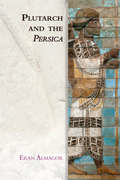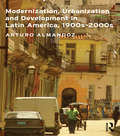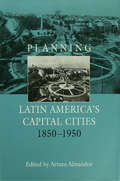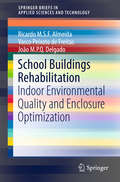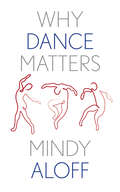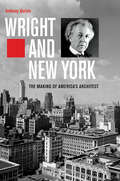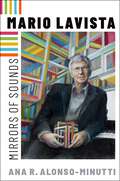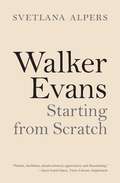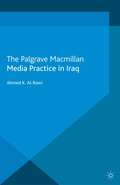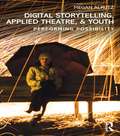- Table View
- List View
Sustainable Materials without the hot air: Making buildings, vehicles and products efficiently and with less new material (without the hot air #6)
by Julian Allwood Jonathan CullenNow in its second edition, Sustainable Materials shows how we can greatly reduce the amount of material demanded and used in manufacturing, while still meeting everyone's needs.Materials, transformed from natural resources into the buildings, equipment, vehicles and goods that underpin our remarkable lifestyle, are made with amazing efficiency. But our growing demand is not sustainable. Production of just five materials – steel, aluminium, paper, plastics and cement – accounts for 55% of industrial emissions, and demand for materials will double by 2050. Can we continue to live well but use less materials? So far people have considered the problem with only one eye open, hoping for a magic solution (such as carbon capture and storage). But with both eyes open we have a whole new set of options. Rather than making more materials, we can use them more wisely – with less material, keeping them for longer, re-using their parts and more. These options make a huge difference: we really could set up our children with a more sustainable life, without compromising our own. Sustainable Materials faces up to the impacts of making materials in the 21st century. Drawing on their experiences working with innovative materials as well as the facts and findings of their research, Julian Allwood and Jonathan Cullen provide an evidence-based vision of change that will allow us to make our future more sustainable. Packed with hundreds of colour photos and helpful graphs and diagrams, Sustainable Materials provides a thorough analysis of the problems that we face through wasteful attitudes and the growing demand for materials, as well as an evaluation of practical and achievable solutions for the future. The first edition of this optimistic and richly-informed book was listed as one of Bill Gate's top reads in 2015, and was also chosen as an Outstanding Academic Title by ACRL Choice magazine. This up-to-date, revised edition is perfect for anyone with an interest in sustainability.
The Developing Language Learner: An Introduction to Exploratory Practice (Research and Practice in Applied Linguistics)
by Dick Allwright Judith HanksThis book-length treatment of Exploratory Practice introduces five propositions about learners as practitioners of learning who are capable of developing their expertise through conducting research in and on their own classroom learning lives.
Plutarch and the Persica
by Eran AlmagorExamines how Cold War films depicted pertinent issues of American social class and gender
Plutarch and the Persica (Edinburgh Studies In Ancient Persia Ser.)
by Eran AlmagorExplores the experiences spectators have when they watch a film collectively in a cinema
Modernization, Urbanization and Development in Latin America, 1900s - 2000s (Planning, History and Environment Series)
by Arturo AlmandozIn this book Arturo Almandoz places the major episodes of Latin America’s twentieth and early twenty-first century urban history within the changing relationship between industrialization and urbanization, modernization and development. This relationship began in the early twentieth century, when industrialization and urbanization became significant in the region, and ends at the beginning of the twenty-first century, when new tensions between liberal globalization and populist nationalism challenge development in the subcontinent, much of which is still poverty stricken. Latin America’s twentieth-century modernization and development are closely related to nineteenth-century ideals of progress and civilization, and for this reason Almandoz opens with a brief review of that legacy for the different countries that are the focus of his book – Mexico, Chile, Brazil, Argentina and Venezuela – but with references to others. He then explores the regional distortions, which resulted from the interaction between industrialization and urbanization, and how the imbalance between urbanization and the productive system helps to explain why ‘take-off’ was not followed by the ‘drive to maturity’ in Latin American countries. He suggests that the close yet troublesome relationship with the United States, the recurrence of dictatorships and autocratic regimes, and Marxist influences in many domains, are all factors that explain Latin America’s stagnation and underdevelopment up to the so-called ‘lost decade’ of 1980s. He shows how Latin America’s fate changed in the late twentieth and early twenty-first century, when neoliberal programmes, political compromise and constitutional reform dismantled the traditional model of the corporate state and centralized planning. He reveals how economic growth and social improvements have been attained by politically left-wing yet economically open-market countries while others have resumed populism and state intervention. All these trends make up the complex scenario for the new century – especially when considered against the background of vibrant metropolises that are the main actors in the book.
Modernization, Urbanization and Development in Latin America, 1900s - 2000s (Planning, History and Environment Series)
by Arturo AlmandozIn this book Arturo Almandoz places the major episodes of Latin America’s twentieth and early twenty-first century urban history within the changing relationship between industrialization and urbanization, modernization and development. This relationship began in the early twentieth century, when industrialization and urbanization became significant in the region, and ends at the beginning of the twenty-first century, when new tensions between liberal globalization and populist nationalism challenge development in the subcontinent, much of which is still poverty stricken. Latin America’s twentieth-century modernization and development are closely related to nineteenth-century ideals of progress and civilization, and for this reason Almandoz opens with a brief review of that legacy for the different countries that are the focus of his book – Mexico, Chile, Brazil, Argentina and Venezuela – but with references to others. He then explores the regional distortions, which resulted from the interaction between industrialization and urbanization, and how the imbalance between urbanization and the productive system helps to explain why ‘take-off’ was not followed by the ‘drive to maturity’ in Latin American countries. He suggests that the close yet troublesome relationship with the United States, the recurrence of dictatorships and autocratic regimes, and Marxist influences in many domains, are all factors that explain Latin America’s stagnation and underdevelopment up to the so-called ‘lost decade’ of 1980s. He shows how Latin America’s fate changed in the late twentieth and early twenty-first century, when neoliberal programmes, political compromise and constitutional reform dismantled the traditional model of the corporate state and centralized planning. He reveals how economic growth and social improvements have been attained by politically left-wing yet economically open-market countries while others have resumed populism and state intervention. All these trends make up the complex scenario for the new century – especially when considered against the background of vibrant metropolises that are the main actors in the book.
Planning Latin America's Capital Cities 1850-1950 (Planning, History And The Environment Ser.)
by Arturo AlmandozIn this first comprehensive work in English to describe the building of Latin America's capital cities in the postcolonial period, Arturo Almandoz and his contributors demonstrate how Europe and France in particular shaped their culture, architecture and planning until the United States began to play a part in the 1930s. The book provides a new per
Planning Latin America's Capital Cities 1850-1950
by Arturo AlmandozIn this first comprehensive work in English to describe the building of Latin America's capital cities in the postcolonial period, Arturo Almandoz and his contributors demonstrate how Europe and France in particular shaped their culture, architecture and planning until the United States began to play a part in the 1930s. The book provides a new per
School Buildings Rehabilitation: Indoor Environmental Quality and Enclosure Optimization (SpringerBriefs in Applied Sciences and Technology)
by Ricardo M.S.F. Almeida Vasco Peixoto de Freitas João M.P.Q. DelgadoThis book discusses the effect of different school building rehabilitation strategies on the classrooms’ indoor environmental quality (IEQ) and presents a multi-objective methodology for school building enclosure optimization combining artificial neural networks and lifecycle costs. The special features of this book are that it (a) presents the state-of-the-art in school building rehabilitation, (b) covers the IEQ assessment of several school buildings, including non-rehabilitated and rehabilitated according to different strategies; and (c) proposes a multi-objective optimization procedure.The rehabilitation of a school building should be regarded as a procedure combining a number of (sometimes conflicting) variables and objectives, including energy, IEQ and costs (initial, operational and maintenance), in the search for an “optimum solution.” The main benefit of the book is that it discusses the main topics related to school building rehabilitation, presents results of the IEQ assessment on 9 school buildings and launches a discussion on how the “in-use” performance of schools is key to understanding how designed performance is actually experienced. It maps the most commonly used multi-objective algorithms and artificial neural network architectures and proposes a methodology for combining these numerical tools with dynamic building simulations and lifecycle cost analysis to optimize school building enclosures. This methodology will be of value to scientists and engineers alike, while also addressing a variety of related disciplines, such as civil and mechanical engineering, architecture and mathematics.
Veiling in Fashion: Space and the Hijab in Minority Communities (Dress Cultures)
by Anna-Mari AlmilaVeiling in Fashion enters the worlds of women who wear the hijab, both as an aspect of their religious observance and community belonging, and as a fashion statement, drawing upon global Islamic fashion history. The book uses rich ethnographic investigation of everyday veiling practices among Muslim women in the city of Helsinki as a lens through which to reflect on and advance understanding of matters concerning Muslim dress in international Muslim minority contexts.The book provides an innovative approach to studying veiling by connecting varied realms of practice, demonstrating how domains as apparently separate as fashion, materiality, city spaces, private life, religious beliefs, and cosmopolitan social conditions are all tightly bound up together in ways that only a sensitive multi-disciplinary approach can reveal. It will appeal to scholars and students in fashion, gender, religion, material cultures, and the construction of space.
Biophilic and Bioclimatic Architecture: Analytical Therapy for the Next Generation of Passive Sustainable Architecture
by Amjad AlmusaedBiophilic and Bioclimatic Architecture is a guide to innovative architectural design for architects, engineers and other specialists who are working with biophilic and bioclimatic architectural concepts. Biophilic and Bioclimatic Architecture has three parts: • Part I focuses on the relationship between architecture and human needs and the creation process, demonstrating the meaning of architectural value in architectural hypothesis. • Part II opens the way towards a new understanding of biophilic architecture as a response to the negative actions of humans and the negative effects of using natural resources. • Part III shows the benefits of combining the effects of the climate with the notion of human comfort in bioclimatic architecture.
Why Dance Matters (Why X Matters Series)
by Mindy AloffA passionate and moving tribute to the captivating power of dance, not just as an art form but as a language that transcends barriers Mindy Aloff, a journalist, an essayist, and a dance critic, analyzes dance as the ultimate expression of human energy and feeling. From her personal anecdotes, her engaging collection of stories about dance from around the world, or her description of the captivating photograph by Helen Levitt of two children dancing, which she sees as one embodiment of the mystery and joy that dancing can evoke, Aloff’s exploration of the aesthetic, social, and spiritual impacts of dance will prove spellbinding. Aloff takes us on a journey through various forms of dance—rituals, religious observances, storytelling, musical interpretations—to show why dance matters to human beings. Interlaced with personal experiences, this book builds on analysis to reveal the intimate relationship we have with dance—personal, spiritual, soul-searching, medicinal, and entertaining. The ideas speak to both specialist and general readers.
When Buildings Speak: Architecture as Language in the Habsburg Empire and Its Aftermath, 1867-1933
by Anthony AlofsinIn When Buildings Speak,Anthony Alofsin explores the rich yet often overlooked architecture of the late Austro-Hungarian Empire and its successor states. He shows that several different styles emerged in this milieu during the late nineteenth and early twentieth centuries. Moreover, he contends that each of these styles communicates to us in a manner resembling language and its particular means of expression. Covering a wide range of buildings—from national theaters to crematoria, apartment buildings to warehouses, and sanatoria to postal savings banks—Alofsin proposes a new way of interpreting this language. He calls on viewers to read buildings in two ways: through their formal elements and through their political, social, and cultural contexts. By looking through Alofsin’s eyes, readers can see how myriad nations sought to express their autonomy by tapping into the limitless possibilities of art and architectural styles. And such architecture can still speak very powerfully to us today about the contradictory issues affecting parts of the former Habsburg Empire. “The book itself as a production is spectacular.”—David Dunster, Architectural Review
Wright and New York: The Making of America's Architect
by Anthony AlofsinA dazzling dual portrait of Frank Lloyd Wright and early twentieth-century New York, revealing the city’s role in establishing the career of America’s most famous architect Frank Lloyd Wright (1867–1959) took his first major trip to New York in 1909, fleeing a failed marriage and artistic stagnation. He returned a decade later, his personal life and architectural career again in crisis. Booming 1920s New York served as a refuge, but it also challenged him and resurrected his career. The city connected Wright with important clients and commissions that would harness his creative energy and define his role in modern architecture, even as the stock market crash took its toll on his benefactors. Wright denounced New York as an “unlivable prison” even as he reveled in its culture. The city became an urban foil for Wright’s work in the desert and in the “organic architecture” he promoted as an alternative to American Art Deco and the International Style. New York became a major protagonist at the end of Wright’s life, as he spent his final years at the Plaza Hotel working on the Guggenheim Museum, the building that would cement his legacy. Anthony Alofsin has broken new ground by mining the recently opened Wright archives held by Columbia University and the Museum of Modern Art. His foundational research provides a crucial and innovative understanding of Wright’s life, his career, and the conditions that enabled his success. The result is at once a stunning biography and a glittering portrait of early twentieth-century Manhattan.
Art and Animals: Natural History, Animal Surfaces, And Art In The Anthropocene (Art and Series)
by Giovanni Aloi'Art is continually haunted by the animal,' wrote Deleuze and Guattari. Over the past two decades, animals have quite literally invaded the gallery space, from Joseph Beuy's co-habiting with a coyote, Janis Kounelli's instillation of live horses, Damien Hirst's shark in formaldehyde to Mark Dion's natural history displays and Marco Evaristti's 'goldfish in a blender'. No longer a passive object in art, animals, the environment they inhabit, and their encounters with humans are central to current artistic debate. This volume addresses the role of the animal in contemporary art, and the controversial artistic approaches that are reconceptualising ideas of primitivism and civilisation.In radical contrast with the mythical and romantic depictions of animals throughout art history, the postmodern animal is problematic and provocative. This text uncovers themes of identity, otherness and humanity in emerging artistic approaches that place the animal at the centre of the scene. Often unnerving, dangerous, and disturbing, the animal of contemporary art poses a challenge to anthropocentricism and forces the viewer to reconsider their relationship to the planet. Giovanni Aloi argues that in light of the fatal challenge imposed by global warming and ecological disasters, there has never been a better time for art to focus on the representation of animals and the natural environment.From the use of living animals in art to the return of taxidermy, Giovanni Aloi considers the moral and ethical implications of visual representations which frame and subjugate wilderness. And as the artificial gallery space houses representations of natural habitats, the relationship between art and the environment is interrogated. Art and Animals surveys the insistent presence of animals in contemporary art, discussing the leading concepts which inform these emerging practises through a range of thought-provoking, innovative, and, at times, dangerous art.
Musik ausstellen: Vermittlung und Rezeption musikalischer Themen im Museum (Edition Museum #53)
by María Del Alonso Amat Elisabeth Magesacher Andreas MeyerMusikausstellungen vermitteln historisches und musikalisches Wissen und können darüber hinaus Orte der Erinnerung, Kontemplation und spielerischen Unterhaltung sein. Entsprechend vielfältig sind inhaltliche Ausrichtungen, museale Vermittlungskonzepte sowie Ansprüche und Erwartungen von Seiten des Publikums. Die Autor*innen des Bandes präsentieren Erkenntnisse aus einem mehrjährigen empirischen Studienprojekt, bei dem Museen verschiedener europäischer Länder erstmalig systematisch-vergleichend als musikkulturelle Institutionen untersucht wurden.
Mario Lavista: Mirrors of Sounds (Currents in Latin American and Iberian Music)
by Ana R. Alonso-MinuttiThis is an open access title available under the terms of a CC BY-NC-ND 4.0 International license. It is free to read at Oxford Scholarship Online and offered as a free PDF download from OUP and selected open access locations. Composer, pianist, editor, writer, and pedagogue Mario Lavista (1943-2021) was a central figure of the cultural and artistic scene in Mexico and one of the leading Ibero-American composers of his generation. His music is often described as evocative and poetic, noted for his meticulous attention to timbre and motivic permutation, and his creative trajectory was characterized by its intersections with the other arts, particularly poetry and painting. Lavista was a relational composer; he did not write music as a private enterprise but for and alongside people with whom he established close relations. Understanding analysis as an affective practice, author Ana R. Alonso-Minutti explores the intertextual connections between the multiple texts--musical or otherwise--that are present in Lavista's music. Alonso-Minutti argues that, through adopting an interdisciplinary and transhistorical approach to music composition, Lavista forged a cosmopolitan imaginary that challenged stereotypes of what Mexican music should sound like. This imaginary becomes a strategy of resistance against imperialist agendas placed upon postcolonial peripheries. Departing from traditional biographical and chronological frameworks that exalt masters and masterworks, the author offers a nuanced, personal narrative informed by conversations with composers, performers, artists, choreographers, poets, writers, and filmmakers. Through an innovative mosaic of methodologies, from archival work, to musical and intertextual analysis, oral history, and (auto)ethnography, this book is the first in-depth study of Lavista's compositional career and offers a contextual panorama of the contemporary music scene in Mexico
Mario Lavista: Mirrors of Sounds (Currents in Latin American and Iberian Music)
by Ana R. Alonso-MinuttiComposer, pianist, editor, writer, and pedagogue Mario Lavista (1943-2021) was a central figure of the cultural and artistic scene in Mexico and one of the leading Ibero-American composers of his generation. His music is often described as evocative and poetic, noted for his meticulous attention to timbre and motivic permutation, and his creative trajectory was characterized by its intersections with the other arts, particularly poetry and painting. Lavista was a relational composer; he did not write music as a private enterprise but for and alongside people with whom he established close relations. Understanding analysis as an affective practice, author Ana R. Alonso-Minutti explores the intertextual connections between the multiple texts--musical or otherwise--that are present in Lavista's music. Alonso-Minutti argues that, through adopting an interdisciplinary and transhistorical approach to music composition, Lavista forged a cosmopolitan imaginary that challenged stereotypes of what Mexican music should sound like. This imaginary becomes a strategy of resistance against imperialist agendas placed upon postcolonial peripheries. Departing from traditional biographical and chronological frameworks that exalt masters and masterworks, the author offers a nuanced, personal narrative informed by conversations with composers, performers, artists, choreographers, poets, writers, and filmmakers. Through an innovative mosaic of methodologies, from archival work, to musical and intertextual analysis, oral history, and (auto)ethnography, this book is the first in-depth study of Lavista's compositional career and offers a contextual panorama of the contemporary music scene in Mexico
Walker Evans: Starting from Scratch
by Svetlana AlpersA magisterial study of celebrated photographer Walker EvansWalker Evans (1903–75) was a great American artist photographing people and places in the United States in unforgettable ways. He is known for his work for the Farm Security Administration, addressing the Great Depression, but what he actually saw was the diversity of people and the damage of the long Civil War. In Walker Evans, renowned art historian Svetlana Alpers explores how Evans made his distinctive photographs. Delving into a lavish selection of Evans’s work, Alpers uncovers rich parallels between his creative approach and those of numerous literary and cultural figures, locating Evans within the wide context of a truly international circle.Alpers demonstrates that Evans’s practice relied on his camera choices and willingness to edit multiple versions of a shot, as well as his keen eye and his distant straight-on view of visual objects. Illustrating the vital role of Evans’s dual love of text and images, Alpers places his writings in conversation with his photographs. She brings his techniques into dialogue with the work of a global cast of important artists—from Flaubert and Baudelaire to Elizabeth Bishop and William Faulkner—underscoring how Evans’s travels abroad in such places as France and Cuba, along with his expansive literary and artistic tastes, informed his quintessentially American photographic style.A magisterial account of a great twentieth-century artist, Walker Evans urges us to look anew at the act of seeing the world—to reconsider how Evans saw his subjects, how he saw his photographs, and how we can see his images as if for the first time.
Media Practice in Iraq
by A. Al-RawiA historical survey of the Iraqi media from its beginning up to the present day, focusing on the post-2003 media scene and the political and societal divisions that occurred in Iraq after US-led occupation. Investigates the nature of the media outlets and offers an analysis of the way Iraqi satellite channels covered the 2010 general elections.
Design-Tech: Building Science for Architects
by Jason Alread Thomas Leslie Robert WhiteheadDesign-Tech is an indispensable, holistic approach to architectural technology that shows you in hundreds of drawings and tables the why as well as the how of building science, providing you with a comprehensive overview. In this expanded edition, measurements and examples are listed in both metric and imperial units to reflect the global reality of architectural practice. The authors also address digital fabrication, construction documentation, ultra-high-rise structures, and zoning codes. And there's more in-depth coverage of structural design and greater emphasis on environmental forces. Numerous case studies demonstrate real-world design implications for each topic, so that you can integrate technical material with design sensibilities. Short chapters explain each topic from first principles in easy-to-reference formats, focusing on what you need to know both at the drawing board and in future discussions with engineers, contractors, and consultants. This new edition incorporates material from continuing curricular experimentation in the SCI-TECH sequence at Iowa State University, which has been recognized with awards and funding from the American Institute of Architects, the U.S. Green Building Council, and the National Council of Architectural Registration Boards.
Design-Tech: Building Science for Architects
by Jason Alread Thomas Leslie Robert WhiteheadDesign-Tech is an indispensable, holistic approach to architectural technology that shows you in hundreds of drawings and tables the why as well as the how of building science, providing you with a comprehensive overview. In this expanded edition, measurements and examples are listed in both metric and imperial units to reflect the global reality of architectural practice. The authors also address digital fabrication, construction documentation, ultra-high-rise structures, and zoning codes. And there's more in-depth coverage of structural design and greater emphasis on environmental forces. Numerous case studies demonstrate real-world design implications for each topic, so that you can integrate technical material with design sensibilities. Short chapters explain each topic from first principles in easy-to-reference formats, focusing on what you need to know both at the drawing board and in future discussions with engineers, contractors, and consultants. This new edition incorporates material from continuing curricular experimentation in the SCI-TECH sequence at Iowa State University, which has been recognized with awards and funding from the American Institute of Architects, the U.S. Green Building Council, and the National Council of Architectural Registration Boards.
The Art of Coding: The Language of Drawing, Graphics, and Animation
by Mohammad Majid al-Rifaie Anna Ursyn Theodor WyeldAs the title suggests, this book explores the concepts of drawing, graphics and animation in the context of coding. In this endeavour, in addition to initiating the process with some historical perspectives on programming languages, it prides itself by presenting complex concepts in an easy-to-understand fashion for students, artists, hobbyists as well as those interested in computer science, computer graphics, digital media, or interdisciplinary studies. Being able to code requires abstract thinking, mathematics skills, spatial ability, logical thinking, imagination, and creativity. All these abilities can be acquired with practice, and can be mastered by practical exposure to art, music, and literature. This book discusses art, poetry and other forms of writing while pondering difficult concepts in programming; it looks at how we use our senses in the process of learning computing and programming. Features: Introduces coding in a visual way Explores the elegance behind coding and the outcome Includes types of outcomes and options for coding Covers the transition from front-of-classroom instruction to the use of online-streamed video tutorials Encourages abstract and cognitive thinking, as well as creativity The Art of Coding contains a collection of learning projects for students, instructors and teachers to select specific themes from. Problems and projects are aimed at making the learning process entertaining, while also involving social exchange and sharing. This process allows for programming to become interdisciplinary, enabling projects to be co-developed by specialists from different backgrounds, enriching the value of coding and what it can achieve. The authors of this book hail from three different continents, and have several decades of combined experience in academia, education, science and visual arts. Source Code: The source code for the book can be accessed here.
The Art of Coding: The Language of Drawing, Graphics, and Animation
by Mohammad Majid al-Rifaie Anna Ursyn Theodor WyeldAs the title suggests, this book explores the concepts of drawing, graphics and animation in the context of coding. In this endeavour, in addition to initiating the process with some historical perspectives on programming languages, it prides itself by presenting complex concepts in an easy-to-understand fashion for students, artists, hobbyists as well as those interested in computer science, computer graphics, digital media, or interdisciplinary studies. Being able to code requires abstract thinking, mathematics skills, spatial ability, logical thinking, imagination, and creativity. All these abilities can be acquired with practice, and can be mastered by practical exposure to art, music, and literature. This book discusses art, poetry and other forms of writing while pondering difficult concepts in programming; it looks at how we use our senses in the process of learning computing and programming. Features: Introduces coding in a visual way Explores the elegance behind coding and the outcome Includes types of outcomes and options for coding Covers the transition from front-of-classroom instruction to the use of online-streamed video tutorials Encourages abstract and cognitive thinking, as well as creativity The Art of Coding contains a collection of learning projects for students, instructors and teachers to select specific themes from. Problems and projects are aimed at making the learning process entertaining, while also involving social exchange and sharing. This process allows for programming to become interdisciplinary, enabling projects to be co-developed by specialists from different backgrounds, enriching the value of coding and what it can achieve. The authors of this book hail from three different continents, and have several decades of combined experience in academia, education, science and visual arts. Source Code: The source code for the book can be accessed here.
Digital Storytelling, Applied Theatre, & Youth: Performing Possibility
by Megan AlrutzDigital Storytelling, Applied Theatre, & Youth argues that theatre artists must re-imagine how and why they facilitate performance practices with young people. Rapid globalization and advances in media and technology continue to change the ways that people engage with and understand the world around them. Drawing on pedagogical, aesthetic, and theoretical threads of applied theatre and media practices, this book presents practitioners, scholars, and educators with innovative approaches to devising and performing digital stories. This book offers the first comprehensive examination of digital storytelling as an applied theatre practice. Alrutz explores how participatory and mediated performance practices can engage the wisdom and experience of youth; build knowledge about self, others and society; and invite dialogue and deliberation with audiences. In doing so, she theorizes digital storytelling as a site of possibility for critical and relational practices, feminist performance pedagogies, and alliance building with young people.


